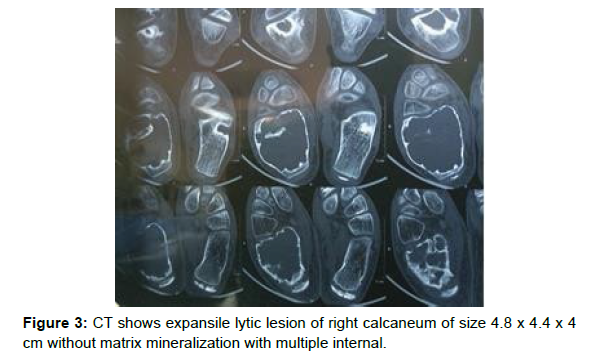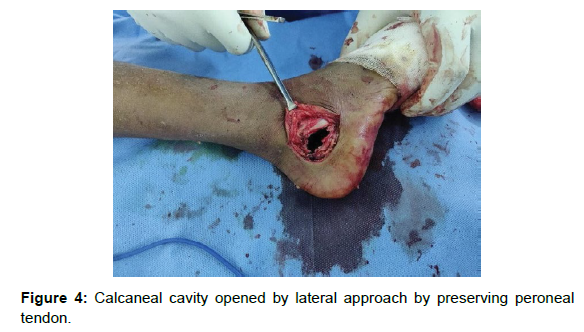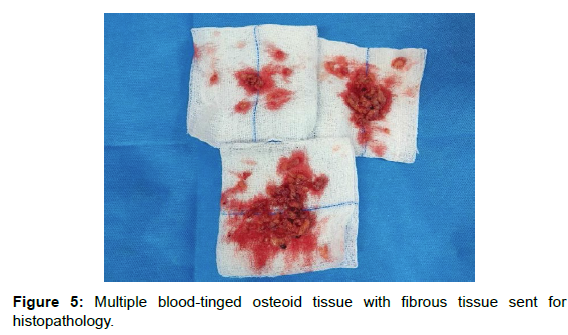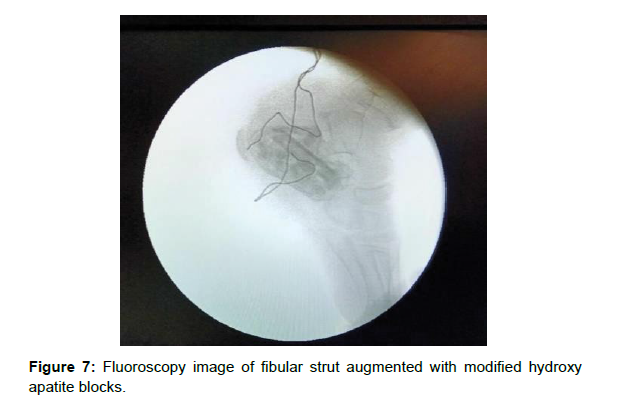Aneurysmal Bone Cyst of Calcaneum â A Rare Case Report
Received: 02-Mar-2023 / Manuscript No. joo-23- 88375 / Editor assigned: 04-Mar-2023 / PreQC No. joo-23- 88375 / Reviewed: 18-Mar-2023 / QC No. joo-23- 88375 / Revised: 24-Mar-2023 / Manuscript No. joo-23- 88375 / Published Date: 28-Mar-2023
Abstract
Introduction: Aneurysmal Bone Cyst is a benign reactive bone lesion filled with multiple blood-filled cavities, locally destructive and expansile lesion. The incidence of Aneurysmal Bone Cyst in tarsal bone is less than 12% of which calcaneum account for about 1.6% of all Aneurysmal Bone Cysts. Here, we report a case of Aneurysmal Bone Cyst of calcaneum which is one of the rarest sites.
Case report: A 10-year-old boy presented with a 3-month history of pain and swelling in right heel, He had previous history of trivial fall and underwent 3 native bandages. On examination he was found to have bony hard swelling from the calcaneum. X-ray and computed tomography were suggestive of an expansile lytic lesion with sclerotic borders with internal septations. Differential diagnosis of Giant Cell Tumour and Aneurysmal Bone Cyst were made. Extended curettage with fibular strut graft augmented with synthetic bone graft substitute (Modified Hydroxyapatite blocks) was done. Histopathology suggestive of Aneurysmal Bone Cyst. Outcome was measured using AOFAS ankle hind foot score.
Discussion: Aneurysmal bone cyst of calcaneum though very rare site of occurrence, should be considered as one of the differential diagnosis for patients with heel pain. Due to inadequate autogenous bone graft, synthetic bone graft substitute was used to fill the defect in paediatric age group. Patient was made to weight bear at 6 weeks and good graft uptake was seen on 3 months postoperatively. At 2 years follow up patient is pain free with excellent AOFAS Ankle hind foot score. To conclude Aneurysmal bone cyst of calcaneum is rare site of its occurrence and for paediatric age group surgical curettage augmented with Fibular strut grafting with bone graft substitute is a valid treatment option.
Introduction
About 85% of cases of Aneurysmal Bone Cyst are younger than 20 years. They are primary benign active vascular lesions of multiple blood-filled cavities, locally destructive and expansile lesion. It is most commonly encountered in the metaphysis of long bones. The incidence of Aneurysmal Bone Cyst in tarsal bone is less than 12% of which calcaneum account for about 1.6% of all Aneurysmal Bone Cysts [1,2].
Thus, here we report our case of rare site of Aneurysmal Bone Cyst calcaneum in the paediatric age group treated with curettage with fibular strut graft bone graft substitute (Synthetic Calcium Hydroxyapatite crystal).
Case report
A 10 years old boy presented with a 3-month history pain and swelling in right heel, swelling and pain gradually increased for the past 1 month and had difficult in walking. He had previous history trauma and underwent 3 native bandages. On examination he was found to have bony hard swelling from the calcaneum.
X-ray and computed tomography suggestive of an expansile lytic lesion with sclerotic borders with internal septations, solitary well defined, radiolucent mass occupying 90 percent of calcaneum with narrow zone of transition, without cortical breech, without periosteal reaction and does not involving the soft tissue [Figures 1 and 2].
Further preceded with CT which showed expansile lytic lesion of right calcaneum of size 4.8 x 4.4x 4 cm without matrix mineralization with multiple internal septae, no adjacent soft tissue mass.
Surgical procedure
Patient in Left lateral position, by lateral approach L-Shaped incision from base of the 5th Metatarsal to posterior aspect of lateral malleolus, Peroneal tendon retracted. Multiple drill holes made on the lateral wall of the calcaneum. Then cavity opened which is filled with multiple fibrous septae and blood. All the contents were scooped out and sent for Histopathological examination [Figures 3-7].
The defect of the size measured 5 cm, so fibular strut graft kept within the cavity and augmented with bone graft substitutes - G Bone (synthetic calcium hydroxyapatite crystals) due to inadequate autogenous bone graft.
HPE report interpreted dense cellular fibro collagenous tissue with numerous multinucleated osteoclastic giant cells interspersed with multiple clefts like cystic spaces and some of them are filled with blood, the cyst walls are lined by giant cells. Area of edema, haemorrhage and hyalinization are also seen. occasional foci show bony spicules. Features consistent with Aneurysmal Bone Cyst [Figure 8].
Post-operative Protocol
Post-operative period was uneventful, Due to lack of soft tissue cover, Wound healing was delayed, and patient was kept on below knee cast and non-Weight bearing for 6 weeks and serial follow up X-Ray taken which shows good Graft up take and consolidation. Outcome was measured using AOFAS ankle hind foot scale.
With 1 year follow up patient had better outcome and with Graft consolidation without any disturbances in gait with full ankle range of motion and excellent AOFAS ankle hind foot scale [Figures 9-10].
Discussion
Term Aneurysmal Bone Cyst was first used in 1942 Jaffe and Lichtenstein on Aneurysmal Bone Cyst Lesions seen on radiograph [3] The incidence of Aneurysmal Bone Cyst in tarsal bone is less than 12% of which calcaneum account for about 1.6% of all Aneurysmal Bone Cysts.
Aneurysmal Bone Cyst are locally destructive and expansile lesion and impinges the surrounding tissue causing, pain and swelling and rarely pathological fractures [2]
Cystic Lesions that affect calcaneum includes, Simple Bone Cyst, Aneurysmal Bone Cyst, Chondroblastoma, Giant Cell Tumor, Osteo Sarcoma (Telangiectatic Variety) [3]. Therefore, exact diagnosis warrants clinical, radiological and histological correlation. Being and unusual site HPE confirmation is necessary to differentiate it from other cystic lesions.
Eighty five percent of the cases of Aneurysmal Bone Cyst are under 20 of age.
60% cases originate from metaphysis, while 28% originate from the meta epiphyseal and sub chondral part [4].
Despite various modalities of treatment such as wide excision or arterial embolization, surgical curettage is sufficient to treat most cases of Aneurysmal Bone Cyst of calcaneum.
• So, our patient was treated with surgical curettage with Fibular sturt graft with bone graft substitute to fill the cavity. With 2 year follow up we have not reported any recurrence of the lesion without any infection.
Conclusion
So, any patient with heel pain and swelling should be subjected to at least radiographic imaging. The cause of heel pain of calcaneum may be any of the above-mentioned lesions. Management protocol varies from lesion to lesion.
To conclude Aneurysmal Bone Cyst of calcaneum is extremely rare, proper diagnosis and appropriate management is necessary to prevent recurrence. Surgical curettage supplemented with Fibular strut grafting with bone graft substitute (Synthetic Calcium hydroxyapatite crystals) is a valuable option in paediatric age group.
References
- Babazadeh S, Broadhead ML, Schlicht SM, Powell GJ, Tymms GM (2011) Pathologic fracture of a calcaneal aneurysmal bone cyst. The Journal of foot and ankle surgery 50:727-732.
- Li M. Cell type expression of RANKL in periprosthetic membrane. Virginia Commonwealth University. 2005.
- Kransdorf MJ, Sweet DE (1995) Aneurysmal bone cyst: concept, controversy, clinical presentation, and imaging. AJR. American journal of roentgenology 164: 573-580.
- Chowdhry M, Chandrasekar CR, Mohammed R, Grimer RJ (2010) Curettage of aneurysmal bone cysts of the feet. Foot & ankle international 31:131-135.
Indexed at, Google Scholar, Crossref
Indexed at, Google Scholar, Crossref
Citation: Velayudham R, Parthasarthy S, Mohanen P, Deiveegan V (2023)Aneurysmal Bone Cyst of Calcaneum – A Rare Case Report. J Orthop Oncol 9:193.
Copyright: © 2023 Velayudham R, et al. This is an open-access article distributedunder the terms of the Creative Commons Attribution License, which permitsunrestricted use, distribution, and reproduction in any medium, provided theoriginal author and source are credited.
Share This Article
Recommended Journals
Open Access Journals
Article Usage
- Total views: 1547
- [From(publication date): 0-2023 - Apr 20, 2025]
- Breakdown by view type
- HTML page views: 1304
- PDF downloads: 243










.png)
.png)